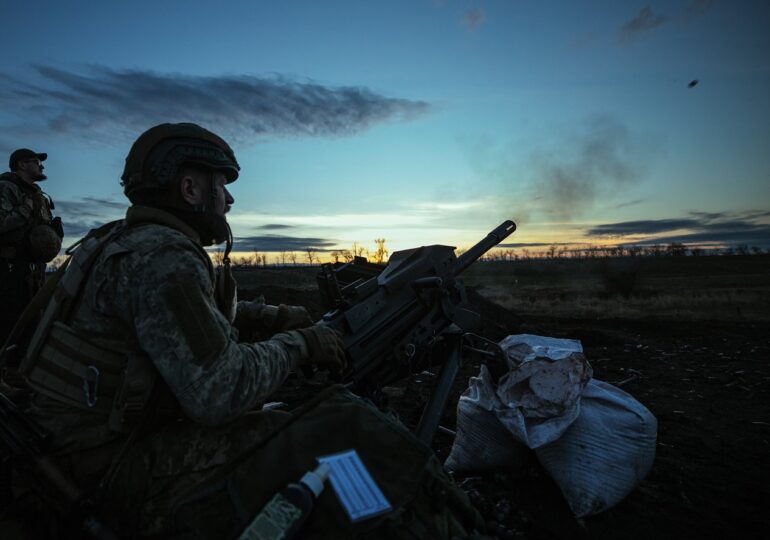In Kiev, the haunting sound of the air raid alarm rings several times a day, usually signaling the arrival of dozens of enemy drones, mostly Shahed. Ukrainian ground forces must shoot them down to keep the capital and its residents safe.
This is the task of the officers and soldiers of the 1129 Anti-Aircraft Defense Regiment, to shoot down enemy drones before they kill, destroy lives, families, and businesses, as reported by Kyiv Post in this unit.
Drones Fall Like Flies
As the Humvee vehicle travels the dusty roads of the Kiev region, a machine gun rattles on one of the seats. When the vehicle reaches the right spot, the mobile anti-aircraft group of two shooters sets up the equipment, which takes only a minute, then waits for the moment of attack, like in a hunt.
"We go out in the field, locate the enemy, navigate with a special program, wait for (the object) to come within the destruction range, and then open fire," explains one of the shooters, Rodion.
He is only in his twenties and gave up college to join the army. He signed a three-year contract and planned to resume his studies, but the war came, and all plans, not just his, went up in smoke.
"My contract was just ending, and I had to finish my studies. But because of the invasion, my university suddenly found itself in occupied territory, so it became more important to fight for my country," he says.
Rodion already has several Shahed drones shot down to his credit. Thanks to automatic guidance programs and a thermal camera, enemy drones can be targeted from a long distance, but the team cannot always tell if they have destroyed them - some continue to fly like dazed flies, and you don't know where they will fall.
"When you hit the payload, it explodes, but sometimes you can damage the wings or the engine, and then there is no explosion. It can still fly a bit and then fall. If it falls in a field, you might find it, but if it crashes in a wooded area, then it's harder," explains the young man.
Shahed drones are one of the biggest threats to Ukraine. They are numerous, cheap, and each carries around 40 kilograms of explosives.
The mobile fire groups are the main defense against these drones, and several hundred such teams operate in the Kiev region.
With Stinger Instead of Machine Gun
The regiment's tactic is simple: the main goal is to patrol the responsibility area and intercept Shahed drones with a large-caliber machine gun and multiple detection systems. Unit members can hit targets several kilometers away.
"Thanks to the equipment, we work both day and night, but it all depends on the distance the target flies. Weather conditions also play a role, like today, when it's cloudy. If (the object) flies behind the clouds, it hinders timely detection, but we adapt," says Stanislav, the vehicle operator.
The problem is that the enemy is not idle either and improves its tactics. "Before, Shahed drones flew straight and at the same altitude. Now, they (the Russians) maneuver them to make detection and interception as difficult as possible. They upgrade the Shahed drones.
They change their tactics, altitude, and trajectory, so each target flies differently. Each mission requires improvisation because the enemy can approach from a different direction," explains the officer.
The team doesn't only use machine guns to target unmanned aerial vehicles (UAVs). The Humvee is equipped with Stinger missiles, so the crew can set up and prepare for the arrival of enemy drones within seconds of reaching a position.
"I spent the whole night tracking Shahed drones. At six in the morning, I found one, and the commander coordinated me. I let it pass overhead before launching the missile. I hit it, it fell to the ground, and exploded," recounts Stanislav.
His commander, Pavlo, says that missiles are more suitable than machine guns for shooting down drones, although Stinger missiles were originally designed to down aircraft.
"Stinger missiles are designed to target large thermal traces, but they are sensitive enough to hit drones. The system is so precise that it can detect the heat traces left by a bird in flight," says Pavlo.
From a Hobby to Drone Hunting
An engineer in civilian life, Pavlo fought in Donbas almost ten years ago. Now, he hunts enemy drones, which is a huge change but strangely similar to the duck hunting he used to practice in his youth.
"I'm a hunter by nature. My dad taught me the craft. Hunting has always been my hobby, and now I hunt different targets. I don't like being in the army, but it's my duty. I'm a husband, a father, and a son - who else will protect my family from aerial attacks?" says Pavlo.
The team is skilled at shooting down drones, but hitting missiles, especially ballistic ones, is another story. This requires more advanced equipment, and strengthening Ukraine's anti-missile defense capabilities is crucial to counter enemy attacks, the publication notes.
For now, Ukraine's air defense units, armed with machine guns and Stingers, will continue to efficiently hunt drones.
Some of the regiment members are already making plans for post-war life. Pavlo doesn't dwell on it too much.
"My plan is just to live, raise my children, and tend to my garden. I have a lot of winter apples and grapes - I love wine!" he says.
T.D.

